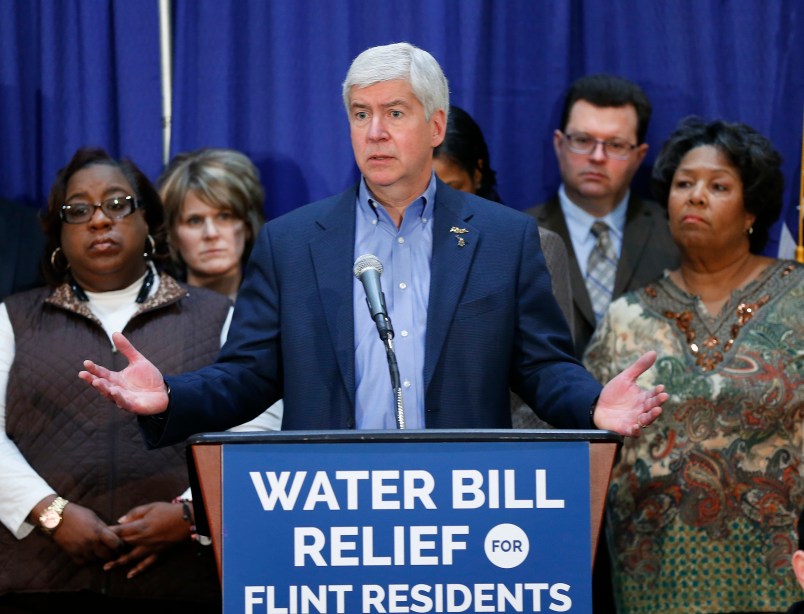FLINT, Mich. (AP) — Michigan Gov. Rick Snyder’s administration has a goal of creating 1,000 new jobs in Flint as a way of helping recover from the ongoing crisis sparked by lead in the city’s water.
Officials in Snyder’s administration discussed the jobs goal Friday in a meeting of the governor’s Flint Water Interagency Task Force, The Detroit News (http://detne.ws/1QSIyVY ) reported.
Rich Baird, the governor’s transformation manager, said the state is negotiating with two “major auto suppliers” about bringing jobs to the city. He told committee members that a non-disclosure agreement meant that he couldn’t name the companies.
Baird also said that his team and Michigan Works! are working to identify 500 “workforce development jobs” that he said are designed to provide good-paying positions and remove obstacles in employment, such as not having access to transportation or child care.
“Mission Flint is really all about the longer-term, prosperous, sustained recovery,” Baird, a Flint native, said in reference to the group of top state officials he leads that was formed to help the city make its water safe again and improve the struggling economy in the city.
Flint, with a population of about 100,000, had switched from Detroit’s water system to the Flint River as a way to save money until a new pipeline to Lake Huron was ready. But during those 18 months, the corrosive water leached lead from the city’s old plumbing because certain treatments weren’t added to the water.
No level of lead in the human body is considered safe, especially in children. The river water also may have been a source of Legionnaires’ disease, which killed at least nine people in the region.
Snyder, whose administration repeatedly downplayed the lead threat, now calls it a “disaster.”
___
Information from: The Detroit News, http://detnews.com/
Copyright 2016 The Associated Press. All rights reserved. This material may not be published, broadcast, rewritten or redistributed.







How about if we start with one new person in Snyder’s job and go from there.
Can someone explain to me how this gets the lead out of the water? Jobs are nice but if you’re dead you really cant take advantage of that.
So this was the plan?!?!? Poison the city, then start a lot of new jobs refurbishing the water infrastructure? Could we have just skipped step one? Mr. Tuff Nerd.*
*if you have to keep telling everyone how tough you are, then you’re probably aren’t. Or you’re a MMA fighter.
Five years too late. The issue is that Flint has been bleeding jobs and residents for decades. (Roger and Me came out in 1989.) Flint is not alone, but Flint and Detroit are two of the most extreme examples of deindustrialization, mostly because they were so dependent on the auto industry. So when a city loses 1/2 its people, but still has to maintain its infrastructure for the original amount; and when the incomes people used to get have been cut by two tier wages; and when the state drastically cuts revenue sharing, the cities lost their revenue base. Snyder said if we cut taxes and make it hard for workers to unionize, the jobs will appear. Well apparently that did not happen in Flint. Even 1000 new jobs does not even begin to make up for the losses. Oh, and there is plenty of good cheap housing in the Flint suburbs, if the new jobs go to newcomers, why would they move to the city, and if the jobs go to Flint city residents, maybe they view it as they finally have enough money to move to the suburbs too.
Realistically Flint has the same scale of needs that New Orleans had after Katrina, maybe even more. But our politics are not set up for that. You got the racist party who blocks help to ‘those’ people but gets help when tornados and floods hit their bits of rural heaven. When trouble like this hits Flint, you get lines like ‘Flint was a victim of mismanagement’, ‘why didn’t they replace the lead lines when they had the chance’, ‘this is a failure of government at all levels.’ But Snyder and the legislative republicans have a greater than usual responsibility in this case, because they installed the emergency manager, when the voters overturned the em law they restored it but in an even harsher version, and it was the EM making the decisions here. They are scapegoating the flint water employees and the EPA at every opportunity, but all their mirrors is broke.